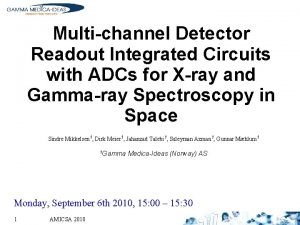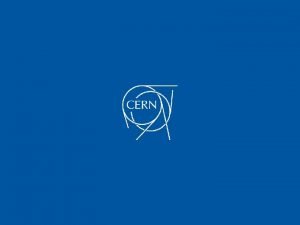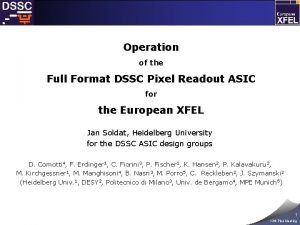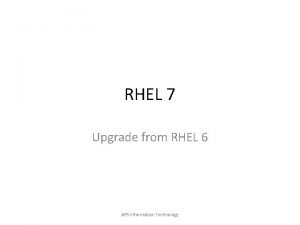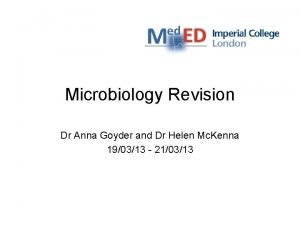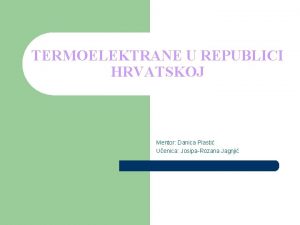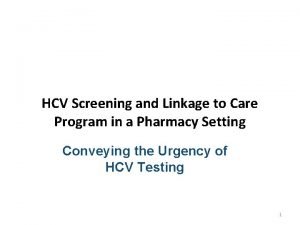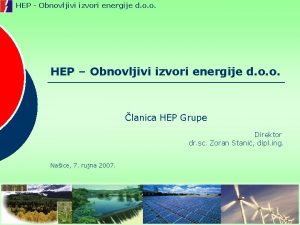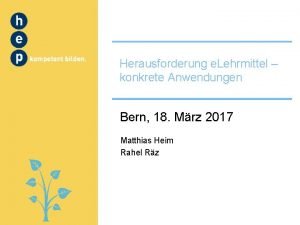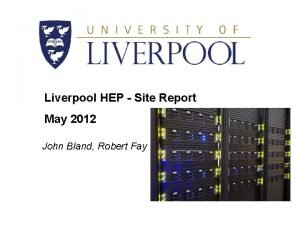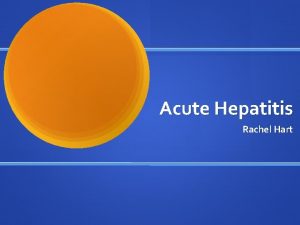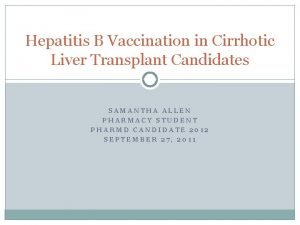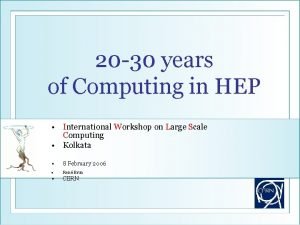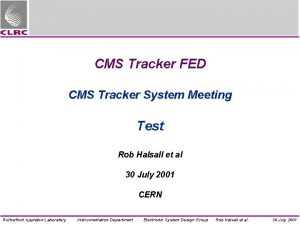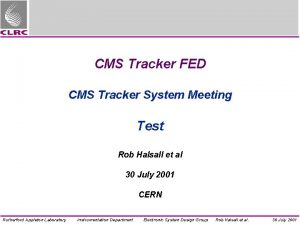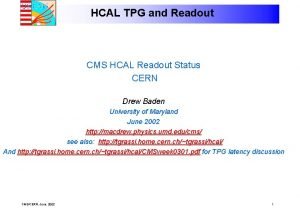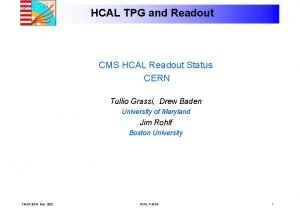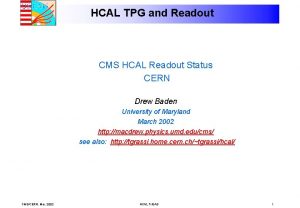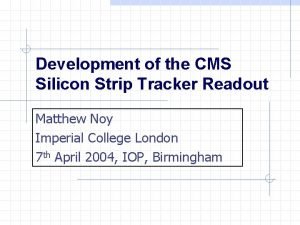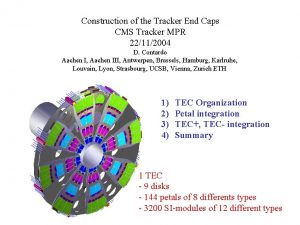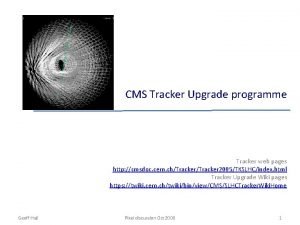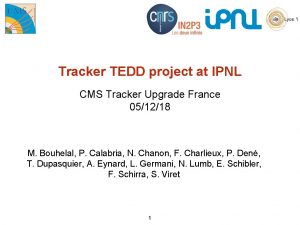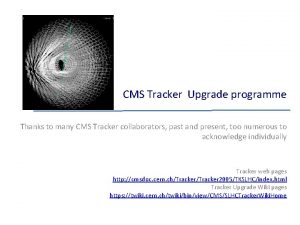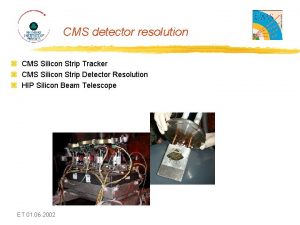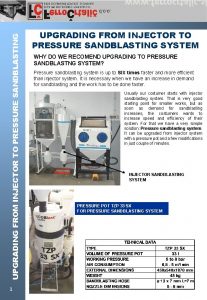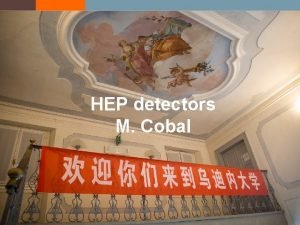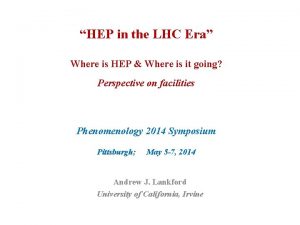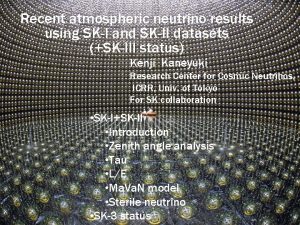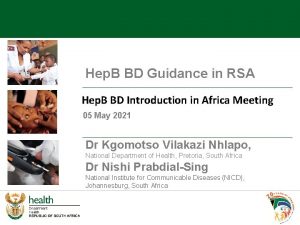HEP 2006 Ioannina Upgrading the CMS Tracker Readout





















- Slides: 21

HEP 2006, Ioannina Upgrading the CMS Tracker Readout Optical Links for Super LHC Stefanos Dris Imperial College London CERN PH-MIC-OE

Objectives & Motivation Introduction • RF Modulation OFDM QAM Tests • • Future Work Conclusion • • The development of a fast digital readout link for Super LHC (SLHC), based on the current CMS Tracker readout optical link components. First proposed in [S. Dris et. al. , LECC 2005, Heidelberg]. Why? The cost of the optoelectronic components represents a large fraction of the CMS Tracker electronics budget. A digital system based on the existing components that can deliver sufficient performance for SLHC operation could potentially be a cost-effective solution. How? The example of DSL: Advanced RF digital modulation is used to transfer data at 2 -8 Mbit/s over copper telephone lines (3 -d. B bandwidth of <30 k. Hz). What is the data rate that we can achieve with bandwidth -efficient digital modulation over the current CMS Tracker optical link?

The Current CMS Tracker Optical Links Introduction RF Modulation OFDM QAM Tests Future Work Conclusion Analog Pulse Amplitude Modulation (PAM) Equivalent digital resolution = 8 bits Sample rate = 40 MSamples/s Equivalent digital data rate = 320 Mbit/s

Digital Communications Introduction RF Modulation OFDM QAM Tests Future Work Conclusion • The Shannon Capacity Shannon determined that the capacity, C, of a noisy communication channel of bandwidth, B, is given by: C=B*log 2(1+SNR) [bits/s]

Digital Communications Introduction RF Modulation OFDM QAM Tests Future Work Conclusion • RF Digital Modulation We will use a passband modulation scheme, i. e. one that uses a sinusoidal carrier, on top of which the data bits are modulated. This allows for greater bandwidth efficiency (since we can send symbols corresponding to multiple bits each).

Quadrature Amplitude Modulation Introduction 11 RF Modulation OFDM Q=+3 V Q*Sin(2πfct) Looks like Euler’s formula! ejω=cos(ω)+j sin(ω) Sin(2πfct) 1101 QAM Tests I*Cos(2πfct) + Q*Sin(2πfct) Cos(2πfct) Future Work Conclusion 01 I=-1 V I*Cos(2πfct) In-Phase Component Quadrature Component

Quadrature Amplitude Modulation Introduction 11 RF Modulation OFDM Q=+3 V Q*Sin(2πfct) Looks like Euler’s formula! ejω=cos(ω)+j sin(ω) Sin(2πfct) 1101 QAM Tests I*Cos(2πfct) + Q*Sin(2πfct) Cos(2πfct) Future Work Conclusion 01 I=-1 V I*Cos(2πfct) • We can represent QAM symbols in the complex plane since they each have a unique amplitude and a phase. • It is used like an eye diagram in binary systems (when successive symbols are plotted). In-Phase Component Quadrature Component

Quadrature Amplitude Modulation Introduction RF Modulation OFDM QAM Tests Future Work Conclusion • Example: 16 -QAM received constellation diagram. 1000 symbols plotted.

Quadrature Amplitude Modulation Introduction RF Modulation • Example: 32 -QAM log 2(32)=5 bits/symbol OFDM QAM Tests Future Work Conclusion • The symbol rate determines the total data rate, as well as the total channel bandwidth required. Of course, the higher the modulation order (i. e. more bits/symbol), the higher the bit error rate (BER).

Multi-Carrier Systems Introduction RF Modulation OFDM QAM Tests Future Work Conclusion • A page out of the ADSL book: Orthogonal Frequency Division Multiplexing (OFDM) Given the available bandwidth of our channel, we can: a) Use a single QAM carrier with a high symbol rate occupying the entire frequency range. b) We can split the channel into smaller slices. Each slice can have a low symbol rate QAM carrier. In systems such as ADSL and Wi-Fi, multiple carriers are used.

Multi-Carrier Systems Introduction RF Modulation OFDM QAM Tests Future Work Conclusion • A page out of the ADSL book: Orthogonal Frequency Division Multiplexing (OFDM) Given the available bandwidth of our channel, we can: a) Use a single QAM carrier with a high symbol rate occupying the entire frequency range. b) We can split the channel into smaller slices. Each slice can have a low symbol rate QAM carrier. In systems such as ADSL and Wi-Fi, multiple carriers are used.

Multi-Carrier Systems Introduction RF Modulation OFDM QAM Tests Future Work Conclusion • A page out of the ADSL book: Orthogonal Frequency Division Multiplexing (OFDM) Given the available bandwidth of our channel, we can: a) Use a single QAM carrier with a high symbol rate occupying the entire frequency range. b) We can split the channel into smaller slices. Each slice has a low symbol rate QAM carrier. The total data rate is the same. In systems such as ADSL and Wi-Fi, multiple carriers are used.

Determining the Capacity • In January 2006 I carried out experiments to determine the capacity of out optical links, using bandwidth efficient digital modulation. • The idea is to emulate a multi-carrier system by passing a single (low symbol rate) carrier each time. • The center frequency of the carrier was varied from ~20 MHz to over 1 GHz. The number of bits/symbol across the entire channel spectrum was determined. • Hence it was possible to extrapolate and determine the total data rate that can be achieved with a QAM-OFDM system. Calculation method in [S. Dris et. al. , LECC 2005, Heidelberg]. Introduction RF Modulation OFDM QAM Tests Future Work Conclusion

Test Setup Introduction RF Modulation OFDM QAM Tests Future Work • Modulator: Agilent E 4438 C Vector Signal Generator. Conclusion Capable of QAM signal generation at symbol rates up to 50 MSymbols/s, and 256 -QAM (8 bits/symbol). Maximum data rate = 50 M*8 = 400 Mbits/s. Generates random data patterns internally. • Demodulator: Agilent E 4440 A Spectrum Analyzer. Capable of QAM demodulation (up to 256 -QAM), with 10 MHz analysis bandwidth. Both instruments are made for telecom applications, and can work with carrier frequencies up to 27 GHz.

Test Setup Introduction RF Modulation OFDM QAM Tests Future Work Conclusion

Test Setup Introduction RF Modulation OFDM QAM Tests Future Work Conclusion

Example Data Introduction RF Modulation OFDM QAM Tests Future Work Conclusion • 32 -QAM (5 bits/symbol), Carrier Frequency=320 MHz, Symbol Rate=1 MS/s, Power=-30 d. Bm From the received constellation above, we can estimate the SNR.

Results Introduction RF Modulation OFDM QAM Tests Future Work Conclusion • Signal to Noise Ratio as a function of carrier frequency The SNR across the entire frequency range of the channel was determined experimentally, for various input signal transmission powers. Using Shannon’s capacity equation, we can calculate the number of bits/symbol that can be assigned to this QAM carrier (given a target BER): C=log 2(1+SNR) [bits/symbol]

Results Introduction RF Modulation OFDM QAM Tests Future Work Conclusion • Achievable data rate for various target BERs The total data rate achievable using QAM-OFDM also depends on the transmission power used. This is implementation specific, and hence the data rate is plotted against transmission power above. The (most likely) achievable data rate is estimated at 4 -4. 5 Gbits/s.

What Will Be Introduction RF Modulation OFDM QAM Tests Future Work Conclusion • The next step in this project is to explore the feasibility of this upgrade in terms of implementation complexity, cost, and R&D effort. • At CERN, we are also looking at a completely new digital optical link, based on Commercial Off The Shelf (COTS) components (See [J. Troska, et. al. , LECC 2005, Heidelberg]). • A prototype modulator/demodulator based on programmable devices, as well as analog components for carrier generation/detection, will be built. • Regardless of the upgrade path chosen, we will soon be looking at techniques derived from advanced communication theory in order to maximize the data rate of the new links. E. g. Forward Error Correcting (FEC) codes, source compression prior to data transmission, ‘smart’ digitization, etc.

Conclusion Introduction RF Modulation OFDM QAM Tests Future Work Conclusion • We have shown that data rates in the Gbit/s range are possible over the CMS Tracker analog readout optical links, using an advanced digital modulation scheme. • Detailed results from the recent tests performed at CERN will be presented at LECC 2006 (Valencia, Spain). • We have taken the first step in understanding advanced communication theory and applying it in the HEP environment. Future fiber-based readout links will undoubtedly benefit from this knowledge. • More R&D and collaboration with industry and engineering departments will be necessary if we are to use such novel concepts in future readout systems.
 Readout integrated circuit
Readout integrated circuit Readout units
Readout units Readout device
Readout device Full pixel readout
Full pixel readout Rhel 6 to 7 upgrade
Rhel 6 to 7 upgrade Flexicoking
Flexicoking Ana hep
Ana hep Hep a vs b vs c
Hep a vs b vs c Termoelektrana sisak
Termoelektrana sisak Hep c results interpretation
Hep c results interpretation Hep b vaccines
Hep b vaccines Hep obnovljivi izvori energije
Hep obnovljivi izvori energije Www hep verlag elehrmittel anleitung
Www hep verlag elehrmittel anleitung Liverpool hep c
Liverpool hep c Hcv symptoms female
Hcv symptoms female Www.cdc.gov/vaccines/schedules/index.html
Www.cdc.gov/vaccines/schedules/index.html Hepatitis b vaccine schedule for adults
Hepatitis b vaccine schedule for adults Hep international
Hep international Hep forum
Hep forum What is hepa b
What is hepa b Hep b mode of transmission
Hep b mode of transmission Khi nào hổ con có thể sống độc lập
Khi nào hổ con có thể sống độc lập
